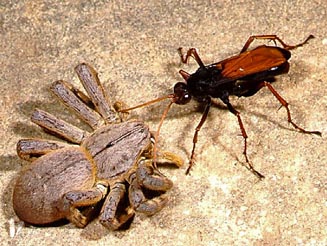

White-tailed Spiders are not aggressive spiders, they tend to bite only if they are provoked, threatened or startled in some way. Spiders are mostly active at night and prevalent from Spring through to late Autumn. They have been found in bundles of clothes left on the floor, washing curtain folds, bathrooms and laundries. This wandering habit, sometimes leads them into buildings or houses where they can be seen on ceilings, the floors and walls. It does not have a permanent home, but wanders around normally at night, hunting for food, which consists of small insects and other spiders. This spider is a common spider, which usually lives in the garden under rocks, leaf litter and the bark of trees.

Male spiders and juveniles often have striped legs and two or four spots at the top of the abdomen as well as one at the tip of the tail.

5 cm long with a lemon pip shape abdomen and a dull cream spot on the tip. The white-tailed spider is a dark, elongated spider, 1 – 2. Whitetail Spider The Whitetailed Spider (Lampona cylindrata) It maybe necessary to vacate for up to 2-4 hours if a misting is recommended by the Exopest technician to knock down the spiders already inside. Please leave the spider webs for a couple of weeks before removing to allow the treatment to work fully.Ĭlotheslines, which should be clothes free, are treated along with outbuildings and letterboxes along with any pot plants and other likely spider harbourages. The external perimeter walls, eaves, verandahs, etc and spider webs are all also sprayed. Very safe synthetic pyrethroids are applied to internal skirtings and other likely harbourages.
Redback spider predators windows#
Our treatment will usually involve the application of a pesticide dust to the roof void, in and around cavities of external windows and doors etc, and under the building (if access is available). We suggest you spray the spider directly with a surface spray or vaccum them up or place in a container using gloves and place outside should they enter after a treatment. We therefore can’t guarantee spiders will not enter the building after spraying. There is no web to return to and should they not be directly sprayed during the treatment they can simply walk into the building with no ill affect. Therefore when we apply residual chemicals to surfaces we cannot rely on these Nomadic spiders coming in contact with the spray unless they decide to rest down on the treated surface, which is very rare. Spiders are affected when a pesticide is absorbed through their body surface (Cuticle). They hunt their prey and roam from area to area. Unfortunately nomadic spiders such as Huntsman and Whitetails do not have webs. Exopest do not recommend spraying for ground dwelling spiders, eg trap door spiders, wolf spiders When to treat?Īt Exopest we would like to explain that a spider treatment in general these days will only effect web spinning spiders, since we are able to sight the webbing and apply pesticide directly to their harbourage and webs. Huntsman are actually very good predators of small iinsects in the home and clean up many unwanted biting insects. In domestic situations Redback spiders and Whitetails are generally regarded as harmful and whilst Huntsman spiders are large, fast and look menacing, the fact is no spider tends to bite unless provoked. The female spider is normally larger than the male. Some spiders have venom that is dangerous to man (Sydney funnel-web, Redback etc) and all spiders grow from an egg some even carried on the back of the female. All spiders make silk and all spiders bite in order to feed. Their bodies are in 2 parts head and abdomen.
Redback spider predators skin#
Spiders are invertebrates (no skeleton) and grow by shedding their skin or cuticle. However there are a hundreds of different species some that should concern us and others that cause no harm. We are all generally familiar with spiders having 8 legs and usually associated with webs.


 0 kommentar(er)
0 kommentar(er)
